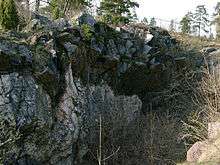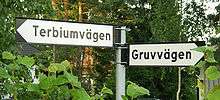Ytterby



Ytterby (Swedish pronunciation: [ˈʏtːərˌbyː]) is a village on the Swedish island of Resarö, in Vaxholm Municipality in the Stockholm archipelago.
The name of the village means "outer village".[1]
Chemical discoveries
At a quarry and mine near the village, the rare earth mineral yttria was discovered and named after the village. This crude mineral eventually proved to be the source of four new elements that were named after the mineral ore and the village. These elements are yttrium (Y), erbium (Er), terbium (Tb), and ytterbium (Yb)[1] and were first described in 1794, 1842, 1842, and 1878, respectively. In 1989 the ASM International society installed a plaque at the former entrance to the mine, commemorating the mine as a historical landmark.[2]
In addition, three other lanthanides, holmium (Ho, named after Stockholm), thulium (Tm, named after Thule, a mythic analog of Scandinavia), and gadolinium (Gd, after the chemist Johan Gadolin) can trace their discovery to the same quarry[3] making it the location with most elements named after it.
See also
References
- 1 2 Emsley, John (2001). Nature's Building Blocks. Oxford University Press. p. 496. ISBN 0-19-850341-5.
- ↑ Blom, Carl-Hugo (18 June 2006). "Ytterby gruva" (in Swedish). Stockholms läns hembygdsförbund. Retrieved 9 June 2007.
- ↑ Kean, Sam (16 July 2010). "Ytterby: The Tiny Swedish Island That Gave the Periodic Table Four Different Elements". Slate. Retrieved 14 November 2016.
Coordinates: 59°25′35.4″N 18°21′12.69″E / 59.426500°N 18.3535250°E
External links
- Blog entry on Ytterby
- YouTube tour of the mine site
- Location on Google Maps
- Web log — What do these elements have in common?